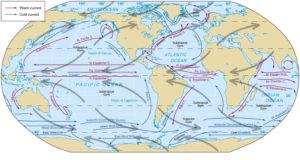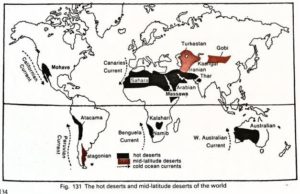Formation of Ocean currents
Formation of Ocean currents
Q) Describe the factors affecting the formation of Ocean currents.
Structure
- Introduction- what are ocean currents
- Body – briefly describe each factor
- Conclusion – its impact or variation etc
Ocean currents are the most important ocean movements because of their influence on climatology of various regions. They represent a regular volume of water in a definite path and direction.
Content
- Ocean currents are influenced by two types of forces namely:
- primary forces that initiate the movement of water;
- secondary forces that influence the currents to flow
- The primary forces that influence the currents are:
- heating by solar energy;
- wind;
- o gravity;
- Coriolis force.
- The secondary forces that influence the currents are:
- Temperature difference;
- Salinity difference
Primary Forces Responsible For Ocean Currents
(i) Influence of insolation
- Heating by solar energy causes the water to That is why, near the equator the ocean water is about 8 cm higher in level than in the middle latitudes.
- This causes a very slight gradient and water tends to flow down the slope. The flow is normally from east to west.
(ii) Influence of wind (atmospheric circulation)
- Wind blowing on the surface of the ocean pushes the water to Friction between the wind and the water surface affects the movement of the water body in its course.
- Winds are responsible for both magnitude and of the ocean Example: Monsoon winds are responsible for the seasonal reversal of ocean currents in the Indian ocean.
- The oceanic circulation pattern roughly corresponds to the earth’s atmospheric circulation pattern
- The air circulation over the oceans in the middle latitudes is mainly anticyclonic [Sub- tropical High Pressure Belt]. The oceanic circulation pattern also corresponds with the same.
- At higher latitudes, where the wind flow is mostly cyclonic , the oceanic circulation follows this pattern
- In regions of pronounced monsoonal flow, the monsoon winds influence the current movements which change directions according to seasons
(iii) Influence of gravity
- Gravity tends to pull the water down to pile and create gradient variation.
(iv) Influence of Coriolis force
- The Coriolis force intervenes and causes the water to move to the right in the northern hemisphere and to the left in the southern hemisphere
- These large accumulations of water and the flow around them are called These produce large circular currents in all the ocean basins. One such circular current is the Sargasso Sea.
Secondary Forces Responsible For Ocean Currents
- Temperature difference and salinity difference are the secondary forces
- Differences in water density affect vertical mobility of ocean currents (vertical currents).
- Water with high salinity is denser than water with low salinity and in the same way cold water is denser than warm water
- Denser water tends to sink, while relatively lighter water tends to rise.
- Cold-water ocean currents occur when the cold water at the poles sinks and slowly moves towards the equator.
- Warm-water currents travel out from the equator along the surface, flowing towards the poles to replace the sinking cold water
Types of Ocean Currents
(i) Based on depth
- The ocean currents may be classified based on their depth as surface currents and deep water currents:
- surface currents constitute about 10 per cent of all the water in the ocean, these waters are the upper 400 m of the ocean;
- deep water currents make up the other 90 per cent of the ocean water. These waters move around the ocean basins due to variations in the density and gravity
- Deep waters sink into the deep ocean basins at high latitudes, where the temperatures are cold enough to cause the density to increase
(ii) Based on temperature
- Ocean currents are classified based on temperature: as cold currents and warm currents:
- Cold currents bring cold water into warm water areas [from high latitudes to low latitudes]. These currents are usually found on the west coast of the continents (currents flow in clockwise direction in northern hemisphere and in anti-clockwise direction in southern hemisphere) in the low and middle latitudes (true in both hemispheres) and on the east coast in the higher latitudes in the Northern Hemisphere;
- Warm currents bring warm water into cold water areas[low to high latitudes] and are usually observed on the east coast of continents in the low and middle latitudes (true in both hemispheres). In the northern hemisphere they are found on the west coasts of continents in high latitudes
General Characteristics of Ocean Currents
Characteristics of Ocean Currents arise due to the interplay of the above-mentioned factors.
- The general movement of the currents in the northern hemisphere is clockwise and in the southern hemisphere, anti-clockwise.
This is due to the Coriolis force which is a deflective force and follows Ferrel's law. A notable exception to this trend is seen in the northern part of the Indian Ocean where the current movement changes its direction in response to the seasonal change in the direction of monsoon winds.
- The warm currents move towards the cold seas and cool currents towards the warm seas.
In the lower latitudes, the warm currents flow on the eastern shores and cold on the western shores [food for imagination]. The situation is reversed in the higher latitudes. The warm currents move along the western shores and the cold currents along the eastern shores.
- Convergence: warm and cold currents meet
- Divergence: a single current splits into multiple currents flowing in different directions
- The shape and position of coasts play an important role in guiding the direction of currents.
The currents flow not only at the surface but also below the sea surface (due to salinity and temperature difference). For instance, heavy surface water of the Mediterranean Sea sinks and flows westward past Gibraltar as a sub-surface current.
Effects of Ocean Currents
Ocean currents have a number of direct and indirect influences on human activities.
(i) Desert formation
- Cold ocean currents have a direct effect on desert formation in west coast regions of the tropical and subtropical continents.
- There is fog and most of the areas are arid due to desiccating effect (loss of moisture).
(ii) Rains
- Warm ocean currents bring rain to coastal areas and even Example: Summer Rainfall in British Type climate.
- Warm currents flow parallel to the east coasts of the continents in tropical and subtropical latitudes. This results in warm and rainy climates. These areas lie in the western margins of the subtropical anti-cyclones.
(iii) Moderating effect
- They are responsible for moderate temperatures at [North Atlantic Drift brings warmness to England. Canary cold current brings cooling effect to Spain, Portugal etc.]
(iv) Fishing
- Mixing of cold and warm ocean currents bear richest fishing grounds in the
- Example: Grand Banks around Newfoundland, Canada and North-Eastern Coast of
- The mixing of warm and cold currents help to replenish the oxygen and favor the growth of planktons, the primary food for fish The best fishing grounds of the world exist mainly in these mixing zones.
(v) Drizzle
- Mixing of cold and warm ocean currents create foggy weather where precipitation occurs in the form of drizzle [Newfoundland].
(vi) Climate
- Results in
- Warm and rainy climates in tropical and subtropical latitudes [Florida, Natal ],
- Cold and dry climates on the western margins in the sub-tropics due to desiccating effect,
- Foggy weather and drizzle in the mixing zones,
- Moderate clime along the western costs in the sub-tropics.
(vii) Tropical cyclones
- They pile up warm waters in tropics and this warm water is the major force behind tropical cyclones
(viii) Navigation
- Currents are referred to by their “drift”. Usually, the currents are strongest near the surface and may attain speeds over five knots Ships usually follow routes which are aided by ocean currents and winds
- Example: If a ship wants to travel from Mexico to Philippines, it can use the route along the North Equatorial Drift which flows from east to west
- When it wants to travel from Philippines to Mexico, it can follow the route along the doldrums when there is counter equatorial current flowing from west to east
(ix) Desert Formation and Ocean Currents
- The aridity of the hot deserts is mainly due to the effects of off-shore Trade Winds, hence they are also called Trade Wind
- The major hot deserts of the world are located on the western coasts of continents between latitudes 15° and 30°N. and S
- They include the biggest Sahara Desert (3.5 million square miles). The next biggest desert is the Great Australian Desert. The other hot deserts are the Arabian Desert, Iranian Desert, Thar Desert, Kalahari and Namib Deserts
- The hot deserts lie along the Horse Latitudes or the Sub-Tropical High Pressure Belts where the air is descending, a condition least favorable for precipitation of any kind to take place
- The rain-bearing Trade Winds blow off-shore and the Westerlies that are on-shore blow outside the desert limits
- Whatever winds reach the deserts blow from cooler to warmer regions, and their relative humidity is lowered, making condensation almost impossible.
- There is scarcely any cloud in the continuous blue The relative humidity is extremely low, decreasing from 60 per cent in coastal districts to less than 30 per cent in the desert interiors. Under such conditions, every bit of moisture is evaporated and the deserts are thus regions of permanent drought. Precipitation is both scarce and most unreliable.
- On the western coasts, the presence of cold currents gives rise to mists and fogs by chilling the on-coming air. This air is later warmed by contact with the hot land, and little rain falls.
-
The desiccating effect of the cold Peruvian Current along the Chilean coast is so pronounced that the mean annual rainfall for the Atacama Desert is not more than 3 cm.

